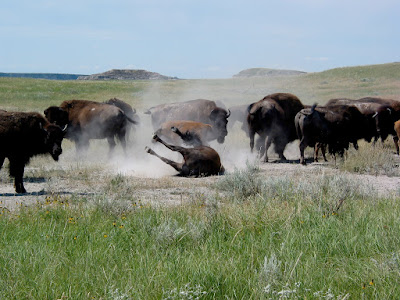20,000 Native Voters for North Dakota?
A version of this article appeared in Rural America In These Times in 2018. For more on topics like this, see my book, American Apartheid: The Native American Struggle....
 |
| Buffalo at play on Standing Rock. |
There appeared to be no way around the problem when North Dakota recently declared that was the case there—no ballot box access for Native voters unless were willing to undertake prohibitively long and costly drives and other hurdles to get an alternate ID. “It is a voter-suppression technique North Dakota targets at its Native population,” accused OJ Semans, the Rosebud Sioux co-director of Four Directions voting rights group.
In September, the Eighth Circuit Court of Appeals backed the North Dakota law in a case brought by the Native American Rights Fund. The next month, the Supreme Court backed them. End of story?
Or not. Why can’t tribes just go right ahead and name and number their roads and highways? mused OJ Semans and Bret Healy, a consultant with Four Directions. What’s to stop them? They are sovereign nations, so there is no reason they can’t use North Dakota’s orderly road-naming conventions, already employed in various forms by cities and counties throughout the state.
The lack of named numbered streets was not a force of nature after all, Semans and Healy realized, but a simple administrative function that needed fixing.
“North Dakota allows the equivalent of same-day registration, so the state’s five tribes can put officials throughout each reservation during the several-week early-voting period, which is already underway, and on Election Day,” said Healy. The tribal officials can provide verification letters with tribally issued residential addresses to Native voters who have lived on the reservation for at least 30 days, he says. The voters can then use the verification letter to vote. “This means the perhaps 20,000 Native Americans of voting age on reservations will be assured they can vote in the November election.”
On October 8, Semans and his wife, Barb, co-directors of Four Directions, announced the new effort to Al Jaeger, the secretary of state and head elections official. They asked for his public support for what they called a “simple, elegant solution” to the problem.
“The state is using its ID law to keep us from voting,” says Semans. “But instead of fighting the law, we are solving the problem it caused.” Secretary of State Al Jaeger’s office has reportedly confirmed the ability of tribes to issue new, updated IDs that allow tribal members to vote.
The press office of Congressman Kevin Cramer (R-N.D.), who is running against current Sen. Heidi Heitkamp (D-N.D.) in November’s election, did not respond with a comment on either the tribal effort or the potential effect on the election of adding so many typically Democratic voters.
Heitkamp—widely considered an embattled senator, perhaps because of her vote against Kavanaugh’s appointment to the Supreme Court—has long advocated for improved Native American voting access. She recently helped introduce a bill to support and enhance Native voting rights. Said Heitkamp, “Given the number of Native Americans who have served, fought, and died for this country, it is appalling that some people would still try and erect barriers to suppress their ability to vote.”

